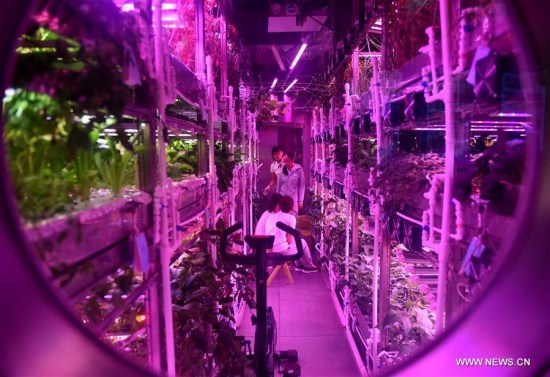
Volunteers have work handover in the simulated space "cabin" Yuegong-1 at Beihang University in Beijing, capital of China, July 9, 2017. (Xinhua/Zhang Chenlin)
Two months ago, postgraduate student Liu Hui traded in store-bought food for long days of picking vegetables, milling flour, and eating bugs.
"All ingredients needed to be hand-picked and cooked fresh," Liu said. "Our everyday meals included tomatoes, green peppers, eggplants and worms."
The biomedicine student from Beihang University was among the first group of four volunteers, two men and two women, to spend 60 days in "Yuegong-1," or Lunar Palace, a simulated "space cabin" in Beijing. The Lunar Palace is meant to increase China's knowledge and technical skills while helping the country's scientists understand what humans need to live on the moon.
Liu and three other volunteers, all civilians and elite postgraduate students from Beihang University, entered the cabin on May 10. On Sunday, they were replaced by a second group, also two men and two women, who will stay there for 200 days. After that, the first group will return for another 105 days.
The experiment, code-named "Yuegong-365," is Beihang's second attempt to see how the Bioregenerative Life Support System (BLSS), in which animals, plants and microorganisms co-exist, works in a lunar environment. Water and food can be recycled within the system, creating an earth-like environment. A successful 105-day trial was conducted in 2014.
Liu Hong, chief designer of "Yuegong-1," said the purpose of the new program is to test the stability of the BLSS when "astronauts" take turns living in the cabin, facing blackouts and other unexpected events.
60 DAYS ON THE "MOON"
"It felt like living in outer space," Liu told Xinhua after the trip. "The BLSS system was the sole lifesaver we relied on."
Each "astronaut" occupied a cubicle about three square meters in area, similar to a capsule hotel, according to Liu. Each cubicle holds a small bed and a folding chair. There is a locker on the wall and a desk nearby.
Liu said that data on everything the volunteers did in the cabin was monitored and stored during their time in the cabin, including the food and water they consumed, their excrement, work and leisure time, physiological indexes in the mornings and in the evenings, and even their mood swings.
"The BLSS is absolutely crucial to probes to the moon and to Mars," said Liu Zhiheng of the Chinese Academy of Sciences. "The latest test is vital to the future of China's moon and Mars missions and must be relied upon to guarantee the safety and health of our astronauts."
To get enough protein, the volunteers raised yellow meal worms, which are edible and contain high levels of protein. They are also rich in phosphorus, potassium and iron as well as trace elements. The worms helped eliminate old leaves on wheat stalks and vegetables, Liu said. The carbon dioxide they exhaled also served to produce a greenhouse effect.
The volunteers prepared the worms by frying them in vegetable oil or mixing them into flour, which was made into buns.
In addition to daily scientific work, the volunteers found ways to entertain themselves.
"We loved playing chess," Liu said. "Throwing darts was also a great way to release stress and liven up the atmosphere."
One of Liu's favorite activities was to ride spinning bikes.
"I worked out in the plant cabin filled with fresh air," Liu said. "The activity not only helped me relax, but also produced carbon dioxide needed for the greenhouse effect."
The volunteers did have mobile phones, computers and the Internet.
"We watched the prime time news on China Central Television at night everyday," said another volunteer, Hu Jingfei. "We kept in touch with our family members with messaging application WeChat and email."
"Yuegong-1" consists of a main living space and two greenhouses for plants. The living structure covers 42 square meters, the size of a small urban apartment, while each of the greenhouses is 3.5 meters high and 50 to 60 square meters in area. The living space has four bed cubicles, a common room, a washroom, a waste treatment room and a room for raising animals. The system allows four volunteers to conduct research while their basic needs are met.


















































